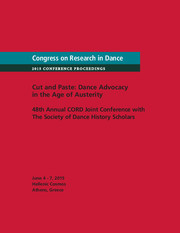No CrossRef data available.
Article contents
The Show Must Go On: A Participatory Rewriting of Euro-American Folk Dance
Published online by Cambridge University Press: 17 September 2015
Abstract
My participatory paper considers Jérôme Bel's seminal work The Show Must Go On as a rewriting of folk dance tradition, drawing from and reinventing popular tropes of the Euro-American relationship to pop music and the popular body. I look at both the piece, and also Bel's methods of restaging it worldwide, as a means of regularizing, reinventing, and reperforming popular dance. I compare his practice to that of national folkdance ensembles that choreograph indigenous traditions for theatrical performance. I am fascinated with this process of fixing “cultural dance” for recognition and consumption by an audience. Bel's work depends on the audience's ability to recognize themselves within its music, imagery, and performing ensemble. Does this make it folk dance? My paper mines the category of “folk dance,” asking whether there is, in fact, a distinction between folk, social, and popular dance and arguing that in the recognizability and participatory nature of his work, he has inadvertently created a contemporary Euro-American folk dance. In addition, I will develop the presentation choreographically, directing the bodies of the listeners in ways meant to evoke Bel's participatory community.
- Type
- Research Article
- Information
- Copyright
- Copyright © Rebecca Pappas 2015


